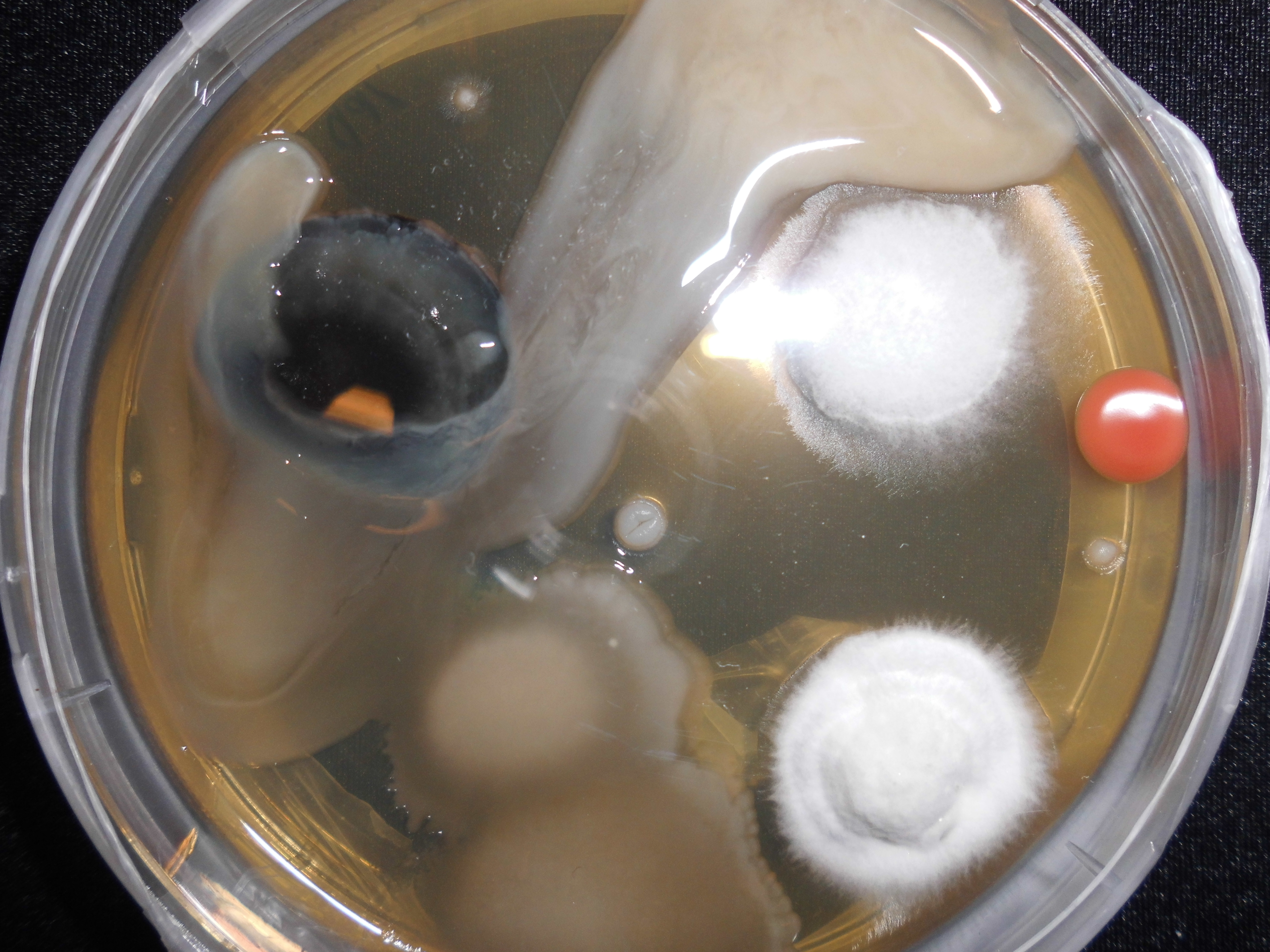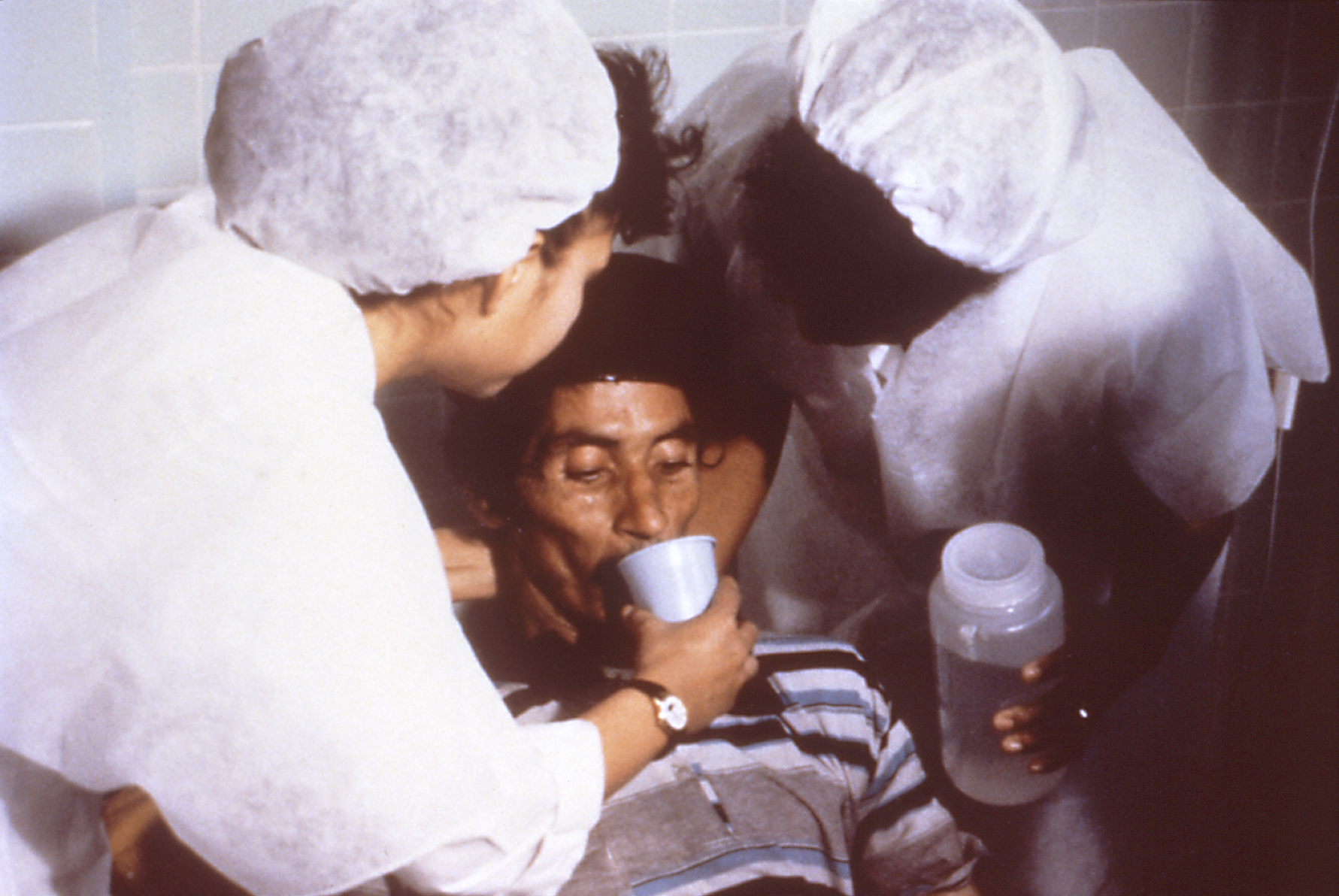|
Vibrio Parahaemolyticus
''Vibrio parahaemolyticus'' (V. parahaemolyticus) is a curved, rod-shaped, Gram-negative bacterium found in the sea and in estuaries which, when ingested, may cause gastrointestinal illness in humans. ''V. parahaemolyticus'' is oxidase positive, facultatively aerobic, and does not form spores. Like other members of the genus ''Vibrio'', this species is motile, with a single, polar flagellum. Pathogenesis While infection can occur by the fecal-oral route, ingestion of bacteria in raw or undercooked seafood, usually oysters, is the predominant cause of the acute gastroenteritis caused by ''V. parahaemolyticus''. Wound infections also occur, but are less common than seafood-borne disease. The disease mechanism of ''V. parahaemolyticus'' infections has not been fully elucidated. Clinical isolates usually possess a pathogenicity island (PAI) on the second chromosome. The PAI can be acquired by horizontal gene transfer and contains genes for several virulence factors. Two fully ... [...More Info...] [...Related Items...] OR: [Wikipedia] [Google] [Baidu] |
Blood Agar Plates
An agar plate is a Petri dish that contains a growth medium solidified with agar, used to culture microorganisms. Sometimes selective compounds are added to influence growth, such as antibiotics. Individual microorganisms placed on the plate will grow into individual colonies, each a clone genetically identical to the individual ancestor organism (except for the low, unavoidable rate of mutation). Thus, the plate can be used either to estimate the concentration of organisms in a liquid culture or a suitable dilution of that culture using a colony counter, or to generate genetically pure cultures from a mixed culture of genetically different organisms. Several methods are available to plate out cells. One technique is known as "streaking". In this technique, a drop of the culture on the end of a thin, sterile loop of wire, sometimes known as an inoculator, is streaked across the surface of the agar leaving organisms behind, a higher number at the beginning of the streak and a lowe ... [...More Info...] [...Related Items...] OR: [Wikipedia] [Google] [Baidu] |
Necrotising Hepatopancreatitis
Necrotising hepatopancreatitis (NHP), is also known as Texas necrotizing hepatopancreatitis (TNHP), Texas Pond Mortality Syndrome (TPMS) and Peru necrotizing hepatopancreatitis (PNHP), is a lethal epizootic disease of farmed shrimp. It is not very well researched yet, but generally assumed to be caused by a bacterial infection. NHP mainly affects the farmed shrimp species ''Litopenaeus vannamei'' (Pacific white shrimp) and ''Litopenaeus stylirostris'' (Western blue shrimp), but has also been reported in three other American species, namely ''Farfantepenaeus aztecus'', '' Farfantepenaeus californiensis'', and ''Litopenaeus setiferus''. The highest mortality rates occur in ''L. vannamei'', which is one of the two most frequently farmed species of shrimp. Untreated, the disease causes mortality rates of up to 90 percent within 30 days. A first outbreak of NHP had been reported in Texas in 1985; the disease then spread to shrimp aquacultures in South America. NHP is associated with a ... [...More Info...] [...Related Items...] OR: [Wikipedia] [Google] [Baidu] |
Litopenaeus
''Litopenaeus'' is a genus of prawns, formerly included in the genus ''Penaeus''. It contains five species: *'' Litopenaeus occidentalis'' (Streets, 1871) *'' Litopenaeus schmitti'' (Burkenroad, 1936) *'' Litopenaeus setiferus'' (Linnaeus, 1767) *'' Litopenaeus stylirostris'' (Stimpson, 1871) *''Litopenaeus vannamei'' (Boone, 1931) Parasites ''Litopenaeus'' is a suspected host of ''Vibrio parahaemolyticus ''Vibrio parahaemolyticus'' (V. parahaemolyticus) is a curved, rod-shaped, Gram-negative bacterium found in the sea and in estuaries which, when ingested, may cause gastrointestinal illness in humans. ''V. parahaemolyticus'' is oxidase positiv ...'', a pathogen of humans. References Penaeidae {{Dendrobranchiata-stub ... [...More Info...] [...Related Items...] OR: [Wikipedia] [Google] [Baidu] |
Clithon Retropictus
''Clithon retropictum''( ko, 기수갈고둥, ja, 石蜑螺) is a species of freshwater and brackish water snail with an operculum, a nerite. It is an aquatic gastropod mollusk in the family Neritidae, the nerites. Distribution This species occurs in Japan: Honshu, Kyushu and Shikoku.Its habitat is also located in South Korea near Jeju. Description Habitat This nerite lives in brackish water as well as freshwater. Feeding habits ''Clithon retropictum'' is herbivorous species. Life cycle ''Clithon retropictum'' is oviparous Oviparous animals are animals that lay their eggs, with little or no other embryonic development within the mother. This is the reproductive method of most fish, amphibians, most reptiles, and all pterosaurs, dinosaurs (including birds), and ....FURUJO Yuki & TOMIYAMA Kiyonori''Distribution and Microhabitat of Coexisting Two Freshwater Snail Species, Semisulcospira libertina (Gould) (Prosobranchia; Pleuroceridae) and Clithon retropictus ( ... [...More Info...] [...Related Items...] OR: [Wikipedia] [Google] [Baidu] |
Bivalvia
Bivalvia (), in previous centuries referred to as the Lamellibranchiata and Pelecypoda, is a class of marine and freshwater molluscs that have laterally compressed bodies enclosed by a shell consisting of two hinged parts. As a group, bivalves have no head and they lack some usual molluscan organs, like the radula and the odontophore. They include the clams, oysters, cockles, mussels, scallops, and numerous other families that live in saltwater, as well as a number of families that live in freshwater. The majority are filter feeders. The gills have evolved into ctenidia, specialised organs for feeding and breathing. Most bivalves bury themselves in sediment, where they are relatively safe from predation. Others lie on the sea floor or attach themselves to rocks or other hard surfaces. Some bivalves, such as the scallops and file shells, can swim. The shipworms bore into wood, clay, or stone and live inside these substances. The shell of a bivalve is composed o ... [...More Info...] [...Related Items...] OR: [Wikipedia] [Google] [Baidu] |
Oral Rehydration Therapy
Oral rehydration therapy (ORT) is a type of fluid replacement used to prevent and treat dehydration, especially due to diarrhea. It involves drinking water with modest amounts of sugar and salts, specifically sodium and potassium. Oral rehydration therapy can also be given by a nasogastric tube. Therapy should routinely include the use of zinc supplements. Use of oral rehydration therapy has been estimated to decrease the risk of death from diarrhea by up to 93%. Side effects may include vomiting, high blood sodium, or high blood potassium. If vomiting occurs, it is recommended that use be paused for 10 minutes and then gradually restarted. The recommended formulation includes sodium chloride, sodium citrate, potassium chloride, and glucose. Glucose may be replaced by sucrose and sodium citrate may be replaced by sodium bicarbonate, if not available. It works as glucose increases the uptake of sodium and thus water by the intestines. A number of other formulations are a ... [...More Info...] [...Related Items...] OR: [Wikipedia] [Google] [Baidu] |
Doxycycline
Doxycycline is a broad-spectrum tetracycline class antibiotic used in the treatment of infections caused by bacteria and certain parasites. It is used to treat bacterial pneumonia, acne, chlamydia infections, Lyme disease, cholera, typhus, and syphilis. It is also used to prevent malaria in combination with quinine. Doxycycline may be taken by mouth or by injection into a vein. Common side effects include diarrhea, nausea, vomiting, abdominal pain, and an increased risk of sunburn. Use during pregnancy is not recommended. Like other agents of the tetracycline class, it either slows or kills bacteria by inhibiting protein production. It kills malaria by targeting a plastid organelle, the apicoplast. Doxycycline was patented in 1957 and came into commercial use in 1967. It is on the World Health Organization's List of Essential Medicines. Doxycycline is available as a generic medicine. In 2020, it was the 79th most commonly prescribed medication in the United States ... [...More Info...] [...Related Items...] OR: [Wikipedia] [Google] [Baidu] |
Immunodeficiency
Immunodeficiency, also known as immunocompromisation, is a state in which the immune system's ability to fight infectious diseases and cancer is compromised or entirely absent. Most cases are acquired ("secondary") due to extrinsic factors that affect the patient's immune system. Examples of these extrinsic factors include HIV infection and environmental factors, such as nutrition. Immunocompromisation may also be due to genetic diseases/flaws such as SCID. In clinical settings, immunosuppression by some drugs, such as steroids, can either be an adverse effect or the intended purpose of the treatment. Examples of such use is in organ transplant surgery as an anti- rejection measure and in patients with an overactive immune system, as in autoimmune diseases. Some people are born with intrinsic defects in their immune system, or primary immunodeficiency. A person who has an immunodeficiency of any kind is said to be immunocompromised. An immunocompromised individual may particular ... [...More Info...] [...Related Items...] OR: [Wikipedia] [Google] [Baidu] |
Fever
Fever, also referred to as pyrexia, is defined as having a temperature above the normal range due to an increase in the body's temperature set point. There is not a single agreed-upon upper limit for normal temperature with sources using values between in humans. The increase in set point triggers increased muscle contractions and causes a feeling of cold or chills. This results in greater heat production and efforts to conserve heat. When the set point temperature returns to normal, a person feels hot, becomes flushed, and may begin to sweat. Rarely a fever may trigger a febrile seizure, with this being more common in young children. Fevers do not typically go higher than . A fever can be caused by many medical conditions ranging from non-serious to life-threatening. This includes viral, bacterial, and parasitic infections—such as influenza, the common cold, meningitis, urinary tract infections, appendicitis, Lassa, COVID-19, and malaria. Non-infectious cause ... [...More Info...] [...Related Items...] OR: [Wikipedia] [Google] [Baidu] |
Cramp
A cramp is a sudden, involuntary, painful skeletal muscle contraction or overshortening associated with electrical activity; while generally temporary and non-damaging, they can cause significant pain and a paralysis-like immobility of the affected muscle. A cramp usually goes away on its own over a period of several seconds, or minutes. Cramps are common and tend to occur at rest, usually at night (nocturnal leg cramps). They are also often associated with pregnancy, physical exercise or overexertion, age (common in older adults), in such cases, cramps are called idiopathic, because there is no underlying pathology. In addition to those benign conditions cramps are also associated with many pathologic conditions. Skeletal muscle cramps may be caused by muscle fatigue or a lack of electrolytes such as sodium (a condition called hyponatremia), potassium (called hypokalemia), or magnesium (called hypomagnesemia). Some skeletal muscle cramps do not have a known cause. Moto ... [...More Info...] [...Related Items...] OR: [Wikipedia] [Google] [Baidu] |
Vomiting
Vomiting (also known as emesis and throwing up) is the involuntary, forceful expulsion of the contents of one's stomach through the mouth and sometimes the nose. Vomiting can be the result of ailments like food poisoning, gastroenteritis, pregnancy, motion sickness, or hangover; or it can be an after effect of diseases such as brain tumors, elevated intracranial pressure, or overexposure to ionizing radiation. The feeling that one is about to vomit is called nausea; it often precedes, but does not always lead to vomiting. Impairment due to alcohol or anesthesia can cause inhalation of vomit, leading to suffocation. In severe cases, where dehydration develops, intravenous fluid may be required. Antiemetics are sometimes necessary to suppress nausea and vomiting. Self-induced vomiting can be a component of an eating disorder such as bulimia, and is itself now classified as an eating disorder on its own, purging disorder. Complications Aspiration Vomiting is dan ... [...More Info...] [...Related Items...] OR: [Wikipedia] [Google] [Baidu] |




